Blog
The Main Rivers of Brazil – Explore the Brazilian Freshwaters
- Thursday May 27th, 2021
- Posted by: Amanda Ennes
- Category: Brazil
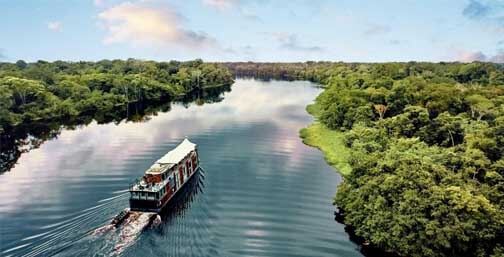
Brazil is home to magnificent beaches, lush forests, and lively cities. From North to South, there are a lot of different things to see and experiment at this megadiverse country. Brazil also has incredible rivers that flow all around the country. Actually, Brazil leads the ranking of countries with the highest freshwater resources in the world, with approximately 8,233 km3. That accounts for 12% of the freshwater resources on the planet!
Next time you are in the country, how about visiting a few rivers in Brazil and checking their great magnificence with your own eyes? Maybe you could do an unforgettable boat tour around their waters as well.
Table of Contents
ToggleRio Amazonas
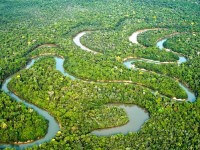 The Amazon River is the world’s largest river by volume of water discharged. One-fifth of all freshwater on the planet flows through the rivers of the Amazon basin. It also supports most of the ecosystem and biodiversity of the country within its basin. The Amazon River is home to hundreds of wildlife in the Amazon region.
The Amazon River is the world’s largest river by volume of water discharged. One-fifth of all freshwater on the planet flows through the rivers of the Amazon basin. It also supports most of the ecosystem and biodiversity of the country within its basin. The Amazon River is home to hundreds of wildlife in the Amazon region.
According to the Brazilian National Water Agency, the Amazon river alone has enough water production to supply 74% of Brazil’s freshwater demand. Needless to say, Rio Amazonas is the most important of all rivers in Brazil. And that is not only because of its greatness but also for its volume of water and for being a powerful source of energy for thousands of species of animals and plants.
Rio Paraná
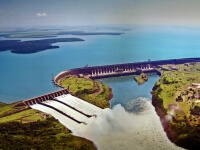 Rio Paraná is part of the Paraná Basin, one of the most important basins of Brazil. It is also home to the Itaipú Dam in Foz do Iguaçu. The Itaipu Hydroelectric Power Plant is the largest generator of hydroelectric power in the world.
Rio Paraná is part of the Paraná Basin, one of the most important basins of Brazil. It is also home to the Itaipú Dam in Foz do Iguaçu. The Itaipu Hydroelectric Power Plant is the largest generator of hydroelectric power in the world.
Moreover, the Paraná River is the second-longest river in Brazil and in South America, measuring 3,942 km. Rio Paraná also serves as a border for Brazil, Argentina, and Paraguay. From the Three Borders Landmark, an obelisk and tourist spot located in Foz do Iguaçu, it is possible to observe the river crossing all three countries.
Rio São Francisco
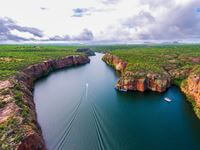 Known as Velho Chico (Old Chico), the San Francisco River is the largest river that runs entirely within the Brazilian territory. With a length of 2,914 kilometers, this river originates in the state of Minas Gerais, crosses Bahia, and washes into the Atlantic Ocean, bordering the states of Alagoas and Sergipe.
Known as Velho Chico (Old Chico), the San Francisco River is the largest river that runs entirely within the Brazilian territory. With a length of 2,914 kilometers, this river originates in the state of Minas Gerais, crosses Bahia, and washes into the Atlantic Ocean, bordering the states of Alagoas and Sergipe.
Rio São Francisco is a special river for the Northeast Region of Brazil. It crosses a semi-arid region of the country which often suffers from droughts. Because of that, the San Francisco River is an important asset for people and animals living in the surrounding areas.
Unfortunately, Rio São Francisco is in danger because of years of mining, deforestation, erosion, and siltation.
Rio Tocantins
 The Tocantins River is one of the most important rivers for river transportation in Brazil, flowing through Goiás, Tocantins, Maranhão, and Pará.
The Tocantins River is one of the most important rivers for river transportation in Brazil, flowing through Goiás, Tocantins, Maranhão, and Pará.
The Tocantins River Basin is home to several species of animals, including 350 species of fishes, 175 of which are endemic. It is also home to the Amazonian manatee, the Araguaian river dolphin, the spectacled caiman, and the yellow-spotted river turtle.
Rio Negro and Rio Solimões
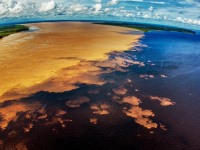 The Meeting of Waters is an astonishing natural phenomenon in the Amazon region. It is also one of the main tourist attractions in Manaus, the capital city of Amazonas state. The Meeting of Waters, or Encontro das Águas in Portuguese, is the confluence between the dark Rio Negro and the muddy Rio Solimões.
The Meeting of Waters is an astonishing natural phenomenon in the Amazon region. It is also one of the main tourist attractions in Manaus, the capital city of Amazonas state. The Meeting of Waters, or Encontro das Águas in Portuguese, is the confluence between the dark Rio Negro and the muddy Rio Solimões.
Due to the differences in temperature, speed, and sediments, their waters do not mix and the two rivers run parallel for miles until they finally become one. When doing a boat tour through the rivers, it is possible to feel the different temperatures between them and check their uniqueness in speed.
How about Rio de Janeiro?
Rio de Janeiro is actually named after a river that doesn’t even exist. That’s right! When the Portuguese first came to Rio de Janeiro in 1502, they thought the Guanabara Bay was a river mouth. It was January and so they named the city Rio de Janeiro (River of January in English). Check other Interesting Facts About Rio de Janeiro and Interesting Facts About Brazil on our blog.
Study Portuguese in Brazil with Caminhos Language Centre.


 Deutsch
Deutsch Français
Français Português
Português Español
Español

Gostaria de agradecer! Por, bisponibiliza. Ótimo trabalho.!
Achei Otimo kkkk